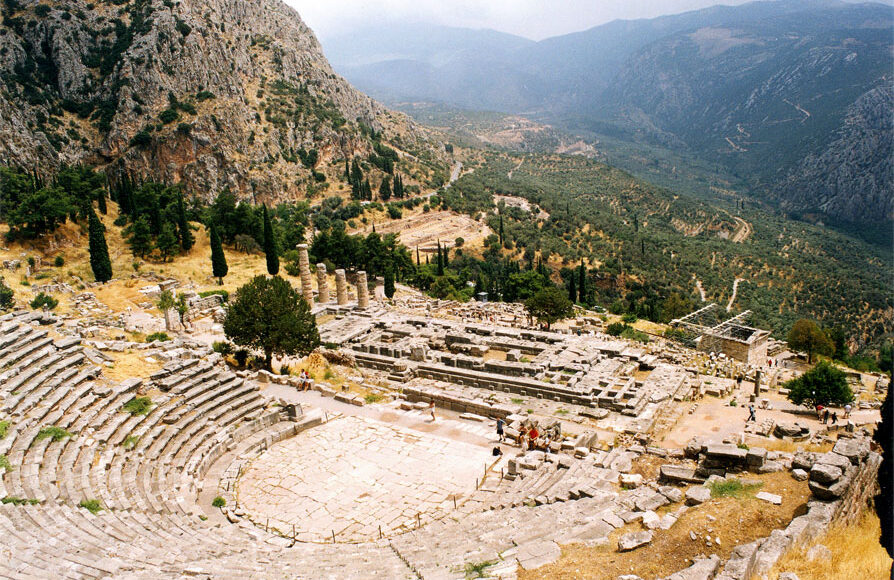You Journey Far, to See if Delphi is Up to Par
You and your friends are Athenian students who wanted to learn more about Delphi. Luckily one student’s father is a priest for the Temple of Apollo in Athens and has secured a tour led by a priest at Delphi for you all. Today you will walk with the priest, discussing monuments and why the jobs of the priests and the Oracle (the Pythia) are so important.
Let’s start the Day with the Sacred Way
Priest: Welcome students! I’m glad you could all join me today for our walk, talk, and visit to the oracle. I started our walk at the Sanctuary of Athena Pronaia because I want to give a tour of all that this beautiful hillside of the Parnassos mountain has to offer. Let’s begin our walk up the hillside, along the Sacred Way.
Now, who knows the story of how this sanctuary came to be and why it’s called the Omphalos?
Student 1: I do! I believe there was a dragon-like beast, called the Python, that guarded the area and was killed by Apollo. Since then, Apollo has been the patron god of Delphi and the Pythian Games celebrate his victory.
And, Zeus determined that Delphi was the center of the world, or the omphalos, by sending out two eagles to the East and West. When both eagles found their way to Delphi it was proclaimed the navel (center) of the world. We can still see the structure that marks where the omphalos is today.
Keep Moving Through and Check Out that Siphnian View!
Priest: Correct! Let’s continue our walk along the Sacred Way and notice on your left the Siphnian Treasury. This lavish treasury is decorated with scenes of a battle between gods and giants; a conflict between Heracles, Zeus, and Apollo; and the judgment of Paris during the Trojan War.
We can see parallels to other monumental structures in the cities of the East. For example, the Apadana has King Darius as the largest figure of authority (with all heads facing him), just as Zeus is the largest figure (figuratively and literally) of authority in the pediment of the Siphnian Treasury.
But if we’re being honest, we are way more humble and pious than this wannabe god, King Darius.
Our visitors recognize that their relationship with the gods will be bettered if they make a sizable donation here at Delphi. As such, treasuries (like the Siphnian Treasury) are constructed to hold all the donated wealth inside. These donations benefit the chances of getting a favorable prophecy from the Oracle.
There are many treasuries, like the Cyrene Treasury and the Athenian Treasury, which we will see as we walk further up the Sacred Way.
Look Ahead and See, the Pythia is About to Make a Prophecy!
Priest: Now take a look at this Temple of Apollo! Inside sits the statue of Apollo and the Pythia on her tripod. She sits in an adyton (a separated area from visitors), as she readies herself to proclaim her prophecy to our guests.
Being a Pythia is not an easy or flattering job. The Pythia is usually an older woman. This woman can be born into peasantry and can have a family, but after she takes her role as Pythia she must leave her family behind.
If one of you were to approach the Pythia you would ask her a yes or no question. She would answer and the priests would give their interpretation of what she has said, but it is up to you to interpret your prophecy.
If I’m honest the priests do most of the work, because I’ve heard the Pythia give her prophecies and it sounds like a bunch of nonsense.
Travelers Come to Where We are Based, it is Our Duty to Host them with Grace!
Priest: Finally, let’s conclude our talk at the top of this amphitheater, as I feel it’s the best view around. Here we hold the Panhellenic Pythian Games every four years. The Sanctuary of Apollo is a Pan-Hellenic sanctuary, meaning it is a sanctuary where every citizen is welcome regardless of where they come from. Like in the Olympic Games, everyone is welcome to come and compete here in our amphitheater, in bouts of the arts; or in the stadium, through competitions of athletic sports. The winner is gifted a beautiful laurel wreath laid upon their head.
Delphi is evidently important. The priests and the oracle determine wars, diplomatic decisions, and heroic expeditions. You can see by the splendor of the monuments and treasures around us, that this truly is the center of our world.
Byline
My name is Bernard McGuire. I am in an Ancient Persia and Ancient Greece History class. Throughout our course I have constantly been hearing about the Oracle of Delphi. When I got the chance, I couldn’t miss the opportunity to look further into it for myself.
